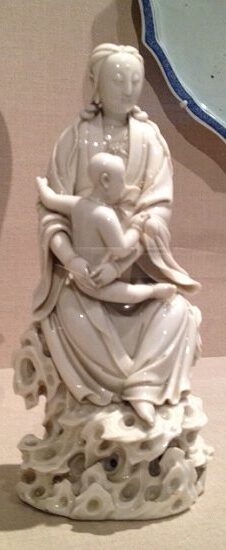
Unknown
Chinese, Fujian province
Bodhisattva Guanyin Presenting a Boy Holding Lotus, 17th c. CE, or 18th, Qing dynasty
Dehua ware, porcelain with white glaze and stamped seal "He Zhangnian”
SBMA, Gift of Mrs. Lockwood de Forest
1984.53.10
“Boy holding lotus” is a visual rebus for “continuously give birth to precious sons”
連生貴子
RESEARCH PAPER
BLANC DE CHINE
Blanc de Chine is a fine, white, vitrified porcelain of great beauty and luster. It was first made in Tehua in the province of Fukien, China, during the fifteenth century--early Ming Dynasty. The pieces were prized for their beauty of form and luster of the glaze. The ware is plain white; and when it has a rosy tinge (very rare), it is especially prized. It is decorated only with incised, impressed, molded, or applied ornaments of rather formal character.
Cups were made shaped like rhinoceros horns, bowls, censers, jardinières, brush pots and small figures of Buddhist and Taoist deities and disciples. (The Goddess of Mercy, Guan Yin, was a favorite Buddhist deity, and many figures of her were made). In the later years of the eighteenth century, 1750-1780, figures of European and Englishmen dressed in their European style clothing were made and exported.
The chief characteristic of Blanc de Chine, aside from its whiteness, is the close bond between the glaze and the biscuit, or body of the pieces. Upon firing, the glaze seemed to sink into the biscuit and become one with it in a way unmatched by any other porcelain. The effect is of softness, and glaze is very smooth to the touch.
The shades of white of the glaze vary from piece to piece, from the blue-white of skimmed milk to cream color. When the white was tinged with rose, which was very rare, the piece was very highly prized. The subtle beauty of the all-white pieces lies in their shape or form.
The clay for the body of the Tehua ware, as Blanc de Chine was sometimes called, before the French wrote about it in their language, was dug from the top of a four hundred foot mountain behind the Tehua kilns. The potters prepared it for use very carefully. The clay was pounded and pulverized, mixed with water, dried, and pulverized again, which made a very fine material for the body of the pieces. But if the material was worked too thin, it was likely to lose its shape on firing in the kiln, and if it was worked too thick, it was likely to crack. At first, the ware was very expensive, but by seventeen hundred it was widely distributed and no longer so expensive.
Blanc de Chine was never intended to be decorated with enamel colors, as other white porcelain from China was decorated, in the eighteenth century some of it was decorated superfluously and “impertinently” (the adverb used by Maria Penskalla) decorated by china painters in England and on the Continent. This over-decorated ware was called “clobbered.”
Simple Blanc de Chine figures from the seventeenth century were exported to Europe in large quantities and were in the collection of Royalties such as the Dresden collection of Augustus the Strong, or the Rosenberg collection in Denmark.
At the end of the eighteenth century, the production of Blanc de Chine declined and came to a stop. Since 1950, however, the Tehua porcelain industry has been reactivated and Blanc de Chine is made for export at Fu-Chou (Foo-Chow).
BIBLIOGRAPHY
Battie, David, ed., Sotheby’s concise Encyclopedia of Porcelain, Little Brown, Boston, Toronto, London, 1990
Hobson, R. L., Chinese Pottery and Porcelain, Dover, NY, 1976
Palmer, Arlene M., A Winterthur Guide to Chinese Export Porcelain; Crown Publishers, Inc., Charlton, .Mass. 1976
Penskalla, Marcia, Magic Blanc de Chine: A handbook for the collector, Interbook International, Shiedam, The Netherlands, 1980.
Victoria and Albert Museum Far Eastern Series, Chinese Ceramics: Porcelain of the Qing Dynasty, 1644-1911, 1986.
From the SBMA Docent Council Asian Arts Study Group, October 25, 1995
Website preparation by Eunice, Drell, January 2005
SBMA CURATORIAL LABELS
During the Ming and Qing dynasties (1368-1911) an independent kiln in Dehua in the Fujian province of southern China became famous for producing white porcelain figurines and vessels popularly known today by their French name, Blanc de Chine. The figurines were first molded and then individually finished by hand. Small holes were left in the ears and mouths of the vessels to permit gases to escape during firing. Blanc de Chine became so popular in Europe that it was later copied in Germany, Austria, France and England.
- SBMA Gallery Label, 2012
